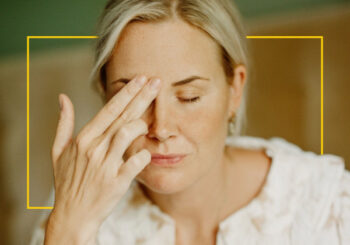Contributing writer for Wake Up World
In the U.S., 19.1% of adults struggle with anxiety, the most common mental illness.1 This may include feelings of persistent and excessive worry about health, family, money or other concerns, or a strong, irrational phobia to a specific situation or object, such as fear of driving or flying.
[pro_ad_display_adzone id=”110028″]
No matter what form it takes on, anxiety can make it difficult to function and carry out your daily routine. It also takes a toll on your well-being, leading to physical symptoms, such as irregular heartbeat, sleep disturbances2 and behavioral changes. Despite its prevalence, only 36.9% of people with anxiety receive treatment.3
Fortunately, there’s a simple tool you can try right in your own home that may relieve anxiety symptoms in a few minutes, just by tapping with your fingers.
Tapping Reduces Anxiety in Just 10 Minutes
Researchers with Corpus Christi Independent School District in Texas conducted a study involving 22 students with anxiety related to a specific phobia.4 The students were randomly assigned to either diaphragmatic breathing or Emotional Freedom Techniques (EFT) as a first treatment, conducted for five two-minute rounds, for a total of 10 minutes per treatment.
EFT is a psychological acupressure technique based on the same energy meridians used in acupuncture. However, instead of stimulating the pathways with needles, EFT uses tapping with your fingertips along with voicing positive affirmations.
In the study, EFT significantly reduced phobia-related anxiety and behavior, both when used as an initial treatment or following diaphragmatic breathing. The findings suggest “EFT is not merely a placebo,” the team said, but “worthy of additional research for the treatment of specific phobias. Furthermore, statistically significant effects were found with a small sample indicating a robust treatment effect.”5
Techniques used in other phobia treatments, namely imaginal exposure, cognitive restructuring and relaxation, are also elements of EFT, which may explain its effectiveness.6 However, EFT may also boost mental health by rebalancing the flow of energy in the body. The study, published in the journal Explore, states:7
“[U]nlike other techniques, EFT is hypothesized to intervene on the body’s energy system through the mechanism of tapping specific energy meridian endpoints. Theories based on the body’s energy system hypothesize that energy blockages or imbalances, often due to trauma or psychological conditioning as in phobias, cause emotions to persist and block the flow of energy.
Removing the blockage and rectifying the flow of energy is believed to alleviate symptoms, such as those experienced in a phobic situation.”
They point to a previous study that used EFT to treat claustrophobia8 as another example of its effectiveness. Just one energy psychology treatment led to measurable changes in electrical conductance between acupuncture points.9
EFT May Tackle Underlying Anxiety Triggers
Though common, anxiety is complex with a number of triggers. EFT may help address many of these underlying factors. Stress is among them. Stressful life events, particularly those related to health or family discord, are associated with increases in anxiety sensitivity, for instance.10
Anxiety evokes the same “fight or flight or freeze” response as stress, meaning that anxiety will trigger a flood of stress hormones, such as adrenaline and cortisol that help you respond in an emergency. EFT is particularly powerful for treating stress and anxiety because it specifically targets your amygdala and hippocampus, which are the parts of your brain that help you decide whether or not something is a threat.11
In one study, EFT led to a significant decrease in levels of the stress hormone cortisol, compared to psychotherapy or no treatment. The decline in cortisol mirrored an improvement in psychological distress.12 Further, energy psychology tools, of which EFT is the most common, may “modulate physiologic maladaptations,” according to a review published in Medical Acupuncture, including:13
- “Exaggerated limbic system responses to innocuous stimuli
- Distortions in learning and memory
- Imbalances between sympathetic and parasympathetic nervous system activity
- Elevated levels of cortisol and other stress hormones
- Impaired immune functioning”
Keeping balance in nervous system activity is important, as your sympathetic nervous system drives the fight or flight response while your parasympathetic nervous system controls “rest and digest” conditions.14 Tapping helps to activate your parasympathetic nervous system, putting the brakes on the stress response and helping to calm down your body.
Traumatic events, like the unexpected loss of a loved one, also increase the risk of anxiety disorders,15 but EFT helps decrease the intensity of traumatic memories after just one session.16 Meanwhile, one-third of U.S. adults usually do not get enough sleep17 — a factor that can make mental health, including anxiety, worse.
Lack of sleep could increase anxiety levels by up to 30%, one study found,18 with Matthew Walker, a UC Berkeley professor of neuroscience and psychology, noting, “Without sleep, it’s almost as if the brain is too heavy on the emotional accelerator pedal, without enough brake.”19 EFT helps in this area, too, improving sleep quality in older adults with insomnia.20
Beyond anxiety, EFT is associated with reductions in depression,21 increases in happiness and improvements in pain and cravings.22 You can use it to relieve negative emotions due to any cause while increasing positive emotions and well-being. EFT is ideal for helping to resolve emotional traumas or gain positive attributes like gratefulness.
How to Perform EFT
Julie Schiffman, EFT tapping therapy practitioner, demonstrates EFT in the video at the top of this page. You can recruit the help of a professional EFT practitioner to use this tool, and this is recommended if you’re suffering from severe anxiety or other mental health conditions.
However, you can also perform EFT on your own. Even children can learn how to use it. And this is one of the reasons why it’s so beneficial — you can do it virtually anywhere.
Tapping is done with your fingertips, solidly but not so hard that it hurts. Ideally, remove any glasses or your watch (which could interfere electromagnetically with the process) prior to tapping, and tap each point five to seven times. The tapping points are below; it’s easiest to start at the top and work your way down.
1.Top of the Head (TH) — With fingers back-to-back down the center of the skull.
2.Eyebrow (EB) — Just above and to one side of the nose, at the beginning of the eyebrow.
3.Side of the Eye (SE) — On the bone bordering the outside corner of the eye.
4.Under the Eye (UE) — On the bone under an eye about 1 inch below your pupil.
5.Under the Nose (UN) — On the small area between the bottom of your nose and the top of your upper lip.
6.Chin (Ch) — Midway between the point of your chin and the bottom of your lower lip. Even though it is not directly on the point of the chin, we call it the chin point because it is descriptive enough for people to understand easily.
7.Collar Bone (CB) — The junction where the sternum (breastbone), collarbone and the first rib meet. This is a very important point and in acupuncture is referred to as K (kidney) 27. To locate it, first place your forefinger on the U-shaped notch at the top of the breastbone (about where a man would knot his tie).
From the bottom of the U, move your forefinger down toward the navel 1 inch and then go to the left (or right) 1 inch. This point is referred to as Collar Bone even though it is not on the collarbone (or clavicle) per se.
8.Under the Arm (UA) — On the side of the body, at a point even with the nipple (for men) or in the middle of the bra strap (for women). It is about 4 inches below the armpit.
9.Wrists (WR) — The last point is the inside of both wrists.
While tapping, you’ll want to hold the problem or negative emotions in your mind while saying (ideally out loud) your positive affirmations, which can take on any number of forms.
A basic phrase to use is, “Even though I have this [you fill in the blank], I deeply and completely love and accept myself.” If you’re in public and don’t want to say your affirmations out loud, it’s acceptable to say them very quietly or in your head, but for best results speak them with feeling and emphasis (even if you don’t believe them yet).
[pro_ad_display_adzone id=”110030″]
Sometimes one round of tapping is enough to clear up an issue while others require multiple rounds. The great thing about EFT is that it costs nothing and you can use it as often as necessary to support your emotional health.
To get an idea of how well it’s working, consider rating your anxiety on a scale of zero to 10 before you start, with zero meaning no anxiety and 10 meaning extreme anxiousness.23 After tapping, rate your anxiety again, repeating the tapping as needed until you feel better.
More Natural Options for Anxiety Relief
EFT is a practical tool that can give you fast relief from anxiety symptoms, but it’s not the only one. If you’re looking for a natural option for anxiety and stress relief, gamma aminobutyric acid (GABA), widely available in supplement and tea forms, should be on your radar.
GABA is a powerful neurotransmitter that inhibits excessive neuronal firing, helping to induce a natural state of calm24 in animal studies,25 while also reducing depression-related behavior.26
Low levels of GABA, or impaired GABA functioning, is associated with multiple mental health conditions, including chronic stress, anxiety disorders and sleep disturbances like insomnia.27 You can also use essential oils like lavender, which is known for its anxiety-relieving and sleep-promoting properties.28
Another trick is to reframe your feelings of anxiety as excitement. These two feelings are similar, but anxiety is considered a negative while excitement is positive. Writing in the Journal of Experimental Psychology, Harvard Business School Professor Alison Wood Brooks explained:29
“Individuals can reappraise anxiety as excitement using minimal strategies such as self-talk (e.g., saying ‘I am excited’ out loud) or simple messages (e.g., ‘get excited’), which lead them to feel more excited, adopt an opportunity mind-set (as opposed to a threat mind-set), and improve their subsequent performance.”
Getting optimal exposure to sunlight daily and regular physical activity, particularly three to five days a week for 45 minutes,30 can also improve mental health. By combining natural strategies such as these with EFT, you can give your mind and body a break from ongoing stress, helping to dampen anxiety and restore balance and calm.
Sources and References:
- 1, 3 Anxiety & Depression Association of America, Anxiety Disorders, Facts & Statistics
- 2 Journal of Psychiatric Research 43(10):926-33
- 4, 5, 6, 7, 9 Explore (NY). 2011 May-Jun;7(3):155-61. doi: 10.1016/j.explore.2011.02.005
- 8 Subtle Energies & Energy Medicine Volume 14, Number 3, Page 239
- 10 J Abnorm Psychol. 2009 Aug; 118(3): 659–669
- 11 Lissa Rankin April 15, 2013
- 12 J Nerv Ment Dis. 2012 Oct;200(10):891-6. doi: 10.1097/NMD.0b013e31826b9fc1
- 13 Med Acupunct. 2017 Aug 1; 29(4): 194–205., Mechanisms of Action
- 14 National Library of Medicine, StatPearls, Neuroanatomy, Parasympathetic Nervous System
- 15 Am J Psychiatry. 2014 Aug 1; 171(8): 864–871
- 16 Traumatology September 1, 2012
- 17 U.S. CDC, Sleep and Sleep Disorders
- 18 Nat Hum Behav (2019) doi:10.1038/s41562-019-0754-8
- 19 Berkeley News November 4, 2019
- 20 Sci Rep. 2022; 12: 6521
- 21 J Evid Based Integr Med. 2018 Jan-Dec;23:2156587218756510
- 22 J Evid Based Integr Med. 2019; 24: 2515690X18823691
- 23 Kaiser Permanente, Emotional Freedom Technique (EFT)
- 24 The Journal of Neuroscience May 1, 2013; 33(18):7770-7
- 25, 26 Translational Psychiatry June 3, 2022, Discussion
- 27 Frontiers in Neuroscience 2020; 14: 923, Intro
- 28 Evid Based Complement Alternat Med. 2013; 2013: 681304
- 29 J Exp Psychol Gen. 2014 Jun;143(3):1144-58
- 30 The Lancet Psychiatry September 1, 2018, Volume 5, Issue 9, P739-746
About the author:
Born and raised in the inner city of Chicago, IL, Dr. Joseph Mercola is an osteopathic physician trained in both traditional and natural medicine. Board-certified in family medicine, Dr. Mercola served as the chairman of the family medicine department at St. Alexius Medical Center for five years, and in 2012 was granted fellowship status by the American College of Nutrition (ACN).
While in practice in the late 80s, Dr. Mercola realized the drugs he was prescribing to chronically ill patients were not working. By the early 90s, he began exploring the world of natural medicine, and soon changed the way he practiced medicine.
In 1997 Dr. Mercola founded Mercola.com, which is now routinely among the top 10 health sites on the internet. His passion is to transform the traditional medical paradigm in the United States. “The existing medical establishment is responsible for killing and permanently injuring millions of Americans… You want practical health solutions without the hype, and that’s what I offer.”
Visit Mercola.com for more information, or read Dr. Mercola’s full bio and resumé here.
[pro_ad_display_adzone id=”110027″]








